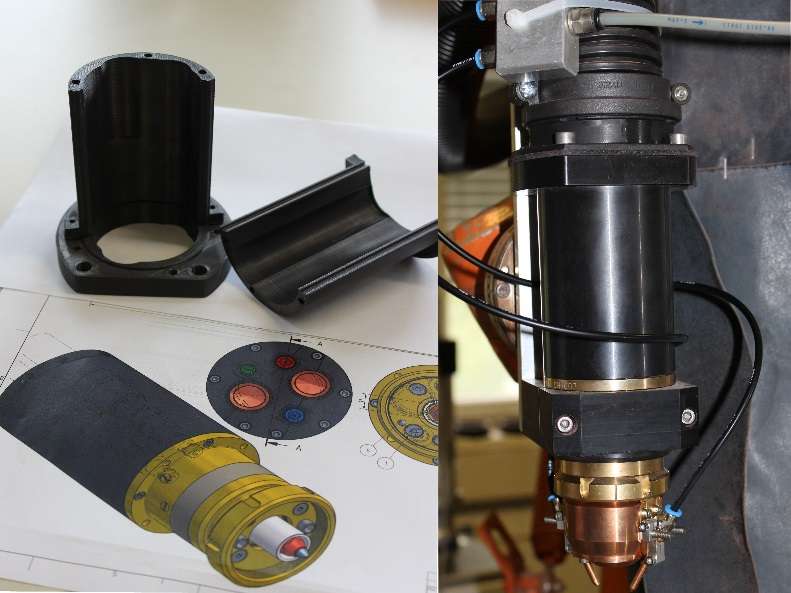Small quantities, a wide variety of parts and high material requirements for the production of plasma coating systems are the daily challenge of Inocon Technologie GmbH. Due to the additive production system and the high-temperature pressure material of EVO-tech, we save up to 90 % of costs in the production of some parts.
Inocon Technologie GmbH has vast experience, success and numerous patents in the field of plasma curing as well as plasma welding and brazing, and has a plasma pre-heater for the silicon industry. Our plasma expertise is completed by a new patented and low-wear plasma coating technology. With its extremely fine, metallic powders and vapors in the atmospheric zone, it is still a very young and poorly explored field of technology. Feeding powder or vapor into the plasma jet, a functional layer is deposited in the atmosphere.
In the course of the development of this new technology, we developed several coatings heads and a new powder infeed technology for extremely fine powders. Using the Inocon plasma technology with powders and vapors, it is possible to apply functional coatings especially even on sensitive substrates. For example, it is possible to apply printed circuit board tracks made of copper or tin onto paper, wood and practically any plastic without damaging the surface to be coated.
This is a remarkable property with regard to the high melting temperatures of powder. Applications for printed circuit board tracks of this kind include cell phone antennas, LED structures or even friction-enhancing or wear-reducing layers.
“We are now in the position to produce individual parts and small batches made of engineering plastics very quickly, while simultaneously saving 90% of the component costs.”
– Dr. Fritz Pesendorfer, owner of Inocon Technologie GmbH
Wide fields of application for plasma heads
The application of thin silicate and silicone layers using vapor generates transparent layers with a thickness of only some nanometers which cover a wide range of applications: the application of hydrophilic or hydrophobic layers as well as barrier, adhesion and also anti-adhesion coating properties on paper, foils and almost any surface.
Current specific applications include the coating of glass and/or ceramics (note: six to seven times the adhesive strength), anti-adhesion coatings on production rollers or even biocidal coatings for various applications (such as anti-fouling for roofs, facades and hulls) and the elimination of germs in hospitals, doctor’s offices, public toilets etc. The Inocon technology is by far the most efficient technology on the market which can replace the presently popular coatings by atmospherically applied coatings using PVD (physical vacuum-based vapor deposition) and CVD (chemical vacuum-based vapor deposition).
Compared to other technologies, the investments to be made for such coatings with at least similar properties are very low, and they can also be integrated in automatic processes. Since it is possible to work at atmospheric pressure, there is no need for vacuum chambers, which allows for shorter cycle times and the coating of larger workpieces.
Broad range of components, small batch sizes
The variety of applications also generates a variety and diversity of requirements for each plant, which are usually integrated in fully automatic systems. The resulting small batch sizes and high variety of parts cause tremendous costs for the production of the required components. This was the reason for Inocon owner, Dr. Fritz Pesendorfer, to visit the opening of the new EVO-tech GmbH production site in Schörfling am Attersee in early February. “I was surprised that we have such an innovative company producing 3D printers in Upper Austria. Personally, I was especially interested in the wide variety of materials such as high-temperature filaments or UV-resistance filaments. Up to now, these were the properties we have been missing so far to be able to use additive production,” says Dr. Pesendorfer.
Shortly after this visit, Inocon Technologie GmbH defined the first test application. The task was to produce a protective cover for the plasma head including three screwable parts using additive technology. Besides high precision, temperature resistance as well as dielectric strength were a decisive criterion for the use of additive production in the small batch production of these components. “I was surprised that it is already possible to process PPS. However, the savings potential of 90 % compared to machining production was even more convincing,” says Pesendorfer.
The reason for the cost savings is obvious: For milling production, 2.3 kg of raw material is required for the three components with 85 % of the material being scrap after production. For additive production, you only apply the material which is actually needed. Moreover, the EVO-tech additive production plant is operated unmanned, and due to the low acquisition costs, they produce at a significantly lower hourly rate compared to the production with a milling machine, resulting in much lower unit costs. “Since it is possible to integrate honeycomb structures in our parts, 3D printers allow for a weight reduction of 50 % which results in tremendous advantages for our movable shafts,” says Markus Rotter, construction engineer.
High potential for the future
The fields of application for Inocon are by far not exhausted.
Due to the high dielectric strength of the EVO-tech PPS, it should soon be possible to replace electronic insulation parts made of PEEK with printed PPS components, thus reducing production costs and increasing flexibility in this field as well. Moreover, our management sees high potential for the future especially in the production of assembly tools and the manufacture of individual parts.
www.evo-tech.eu

 Deutsch (Germany)
Deutsch (Germany)  Polski (PL)
Polski (PL) 









